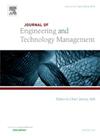工匠和数字化转型:后新冠时代的商业战略和合同
IF 3.9
3区 管理学
Q2 BUSINESS
Journal of Engineering and Technology Management
Pub Date : 2025-10-01
DOI:10.1016/j.jengtecman.2025.101917
引用次数: 0
摘要
传统上,工匠们依靠邻近的市场和本地化的地区来开展业务,而无需在数字解决方案上进行大量投资。然而,2019冠状病毒病大流行需要采用数字解决方案来进入市场,同时也提供了意想不到的机会,例如国际曝光。这种投资需要工匠的商业战略彻底改变,并在大流行后时期持续存在,需要持续的新投资。在本研究中,我们对762名意大利工匠的样本采用结构方程模型,研究后疫情商业策略如何影响数字营销和数字技术的投资,以及它们对绩效的后续影响。此外,本研究旨在探讨工匠通过与战略合作伙伴签订后疫情商业和数字合同获得的优势,这些合作伙伴因疫情而加入了商业模式。通过这样做,我们展示了这些合同类型对企业商业战略和数字化相关采用路径的深刻影响,并有助于更好地理解推动手工艺行业技术采用的因素。本文章由计算机程序翻译,如有差异,请以英文原文为准。
Craftsmen and digital transformation: Business strategies and contracts in a post-Covid world
Craftsmen traditionally relied on proximity markets and localized territories to conduct their business without heavy investments in digital solutions. However, the Covid-19 pandemic necessitated the adoption of digital solutions to access markets also giving unexpected opportunities like, for example, international exposure. Such investments required a complete change in the craftsmen's business strategies and persisted in the post-pandemic period requesting continuous and new investments. In this study, we employ Structural Equation Modeling on a sample of 762 Italian craftsmen to investigate how the post-Covid business strategies influence the investments in both digital marketing and digital technologies and their subsequent impact on performance. Furthermore, this study seeks to explore the advantages that craftsmen derive from subscribing to post-Covid commercial and digital-based contracts with strategic partners that joined the business model due to the pandemic. By doing so, we demonstrate the profound influence of these contract types on firms' business strategies and digital-related adoption paths and contribute to a better understanding of the factors driving technology adoption in craftsmen industry.
求助全文
通过发布文献求助,成功后即可免费获取论文全文。
去求助
来源期刊
CiteScore
8.00
自引率
6.20%
发文量
29
审稿时长
>12 weeks
期刊介绍:
The Journal of Engineering and Technology Management (JET-M) is an international scholarly refereed research journal which aims to promote the theory and practice of technology, innovation, and engineering management.
The journal links engineering, science, and management disciplines. It addresses the issues involved in the planning, development, and implementation of technological capabilities to shape and accomplish the strategic and operational objectives of an organization. It covers not only R&D management, but also the entire spectrum of managerial concerns in technology-based organizations. This includes issues relating to new product development, human resource management, innovation process management, project management, technological fusion, marketing, technological forecasting and strategic planning.
The journal provides an interface between technology and other corporate functions, such as R&D, marketing, manufacturing and administration. Its ultimate goal is to make a profound contribution to theory development, research and practice by serving as a leading forum for the publication of scholarly research on all aspects of technology, innovation, and engineering management.

 求助内容:
求助内容: 应助结果提醒方式:
应助结果提醒方式:


